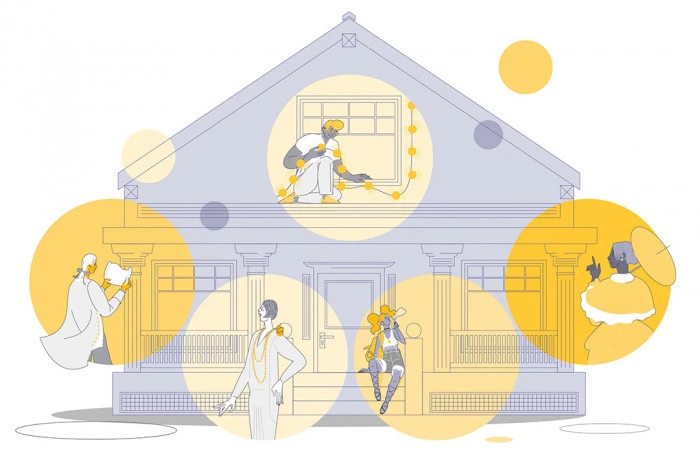Share what you know,
and discover more.
Share what you know,
and discover more.
Jul 11, 2022

-

- Jane Lonnquist
What I Know About This House
We are the ninth family to live in this house. Marie and Oswald Risvold bought it in 1927 for $2,385. Two years later it was sold to Gladys and Andrus Thorpe. Andrus/Andy was the oldest son of Samuel Skidmore Thorpe, the co-founder of Thorpe Brothers Realty, which developed this neighborhood out of farmland in the 1920s. Modeled after other planned neighborhoods in Baltimore and Kansas City, Thorpe introduced many suburban planning principles in an era before zoning regulations. Deed restrictions in the Country Club District carefully controlled home designs and, unfortunately, prohibited sale or lease "to any person other than the white or Caucasian race.” An organization called Just Deeds made it possible for us to add a document to the deed which renounces that racist language, although it will always be part of the home's historic record. The Country Club neighborhood was listed on National Register of Historic Places for significance in three areas: community planning, landscape architecture, and the fine collection of period revival architectural styles. Our house is a Spanish Colonial Revival style with green Spanish clay tile made by Ludowici. The previous owners added a large addition to the back of the house in 1981. We remodeled the kitchen in 2006 and found (and framed) some paper treasures under the bottom stair tread, which seem to be from 1927, although the year isn't shown. Sadly, we had to sacrifice the house's laundry chute to reconfigure the kitchen, but we still have the two old phone nooks in the house. The living room fireplace has original tiles which are Wheatley Faience from Cincinnati. (A photo of the two unique textured ship tiles sent to the local store Clay Squared yielded this information from the Tile Heritage Foundation.) When we had the wood floors refinished, we showed the foreman a mason jar of stain we had found in the basement. He looked at the handwritten label and declared that it was his own father's writing from years ago when he must have done the floors in this house. We've had the pleasure of having two previous homeowners visit us out of the blue. In 2006, Janney and Carolyn Kingsland, who lived here in 1949-1957, came. They answered our question about a strange electrical switch in the closet of the primary bedroom. It activated an alarm their parents installed to go off if Carolyn left her bedroom at night. Her sleepwalking was so profound that she had been found asleep in a snowbank a block from home! She claims that the alarmed gate to her bedroom not only kept them informed, but cured her of sleepwalking. In 2007, Bruce Christiansen, who lived here 1937-1949, visited with his son Paul. They sent some great photos of the house from that period, showing shutters and a wrought iron railing by the front door that are no longer there. Overall, however, 4510 Drexel looks just the same from the street as it does in these photos. It's a great old house!
What I Know About This House
We are the ninth family to live in this house. Marie and Oswald Risvold bought it in 1927 for $2,385. Two years later it was sold to Gladys and Andrus Thorpe. Andrus/Andy was the oldest son of Samuel Skidmore Thorpe, the co-founder of Thorpe Brothers Realty, which developed this neighborhood out of farmland in the 1920s. Modeled after other planned neighborhoods in Baltimore and Kansas City, Thorpe introduced many suburban planning principles in an era before zoning regulations. Deed restrictions in the Country Club District carefully controlled home designs and, unfortunately, prohibited sale or lease "to any person other than the white or Caucasian race.” An organization called Just Deeds made it possible for us to add a document to the deed which renounces that racist language, although it will always be part of the home's historic record. The Country Club neighborhood was listed on National Register of Historic Places for significance in three areas: community planning, landscape architecture, and the fine collection of period revival architectural styles. Our house is a Spanish Colonial Revival style with green Spanish clay tile made by Ludowici. The previous owners added a large addition to the back of the house in 1981. We remodeled the kitchen in 2006 and found (and framed) some paper treasures under the bottom stair tread, which seem to be from 1927, although the year isn't shown. Sadly, we had to sacrifice the house's laundry chute to reconfigure the kitchen, but we still have the two old phone nooks in the house. The living room fireplace has original tiles which are Wheatley Faience from Cincinnati. (A photo of the two unique textured ship tiles sent to the local store Clay Squared yielded this information from the Tile Heritage Foundation.) When we had the wood floors refinished, we showed the foreman a mason jar of stain we had found in the basement. He looked at the handwritten label and declared that it was his own father's writing from years ago when he must have done the floors in this house. We've had the pleasure of having two previous homeowners visit us out of the blue. In 2006, Janney and Carolyn Kingsland, who lived here in 1949-1957, came. They answered our question about a strange electrical switch in the closet of the primary bedroom. It activated an alarm their parents installed to go off if Carolyn left her bedroom at night. Her sleepwalking was so profound that she had been found asleep in a snowbank a block from home! She claims that the alarmed gate to her bedroom not only kept them informed, but cured her of sleepwalking. In 2007, Bruce Christiansen, who lived here 1937-1949, visited with his son Paul. They sent some great photos of the house from that period, showing shutters and a wrought iron railing by the front door that are no longer there. Overall, however, 4510 Drexel looks just the same from the street as it does in these photos. It's a great old house!
Jul 11, 2022
What I Know About This House
We are the ninth family to live in this house. Marie and Oswald Risvold bought it in 1927 for $2,385. Two years later it was sold to Gladys and Andrus Thorpe. Andrus/Andy was the oldest son of Samuel Skidmore Thorpe, the co-founder of Thorpe Brothers Realty, which developed this neighborhood out of farmland in the 1920s. Modeled after other planned neighborhoods in Baltimore and Kansas City, Thorpe introduced many suburban planning principles in an era before zoning regulations. Deed restrictions in the Country Club District carefully controlled home designs and, unfortunately, prohibited sale or lease "to any person other than the white or Caucasian race.” An organization called Just Deeds made it possible for us to add a document to the deed which renounces that racist language, although it will always be part of the home's historic record. The Country Club neighborhood was listed on National Register of Historic Places for significance in three areas: community planning, landscape architecture, and the fine collection of period revival architectural styles.Our house is a Spanish Colonial Revival style with green Spanish clay tile made by Ludowici. The previous owners added a large addition to the back of the house in 1981. We remodeled the kitchen in 2006 and found (and framed) some paper treasures under the bottom stair tread, which seem to be from 1927, although the year isn't shown. Sadly, we had to sacrifice the house's laundry chute to reconfigure the kitchen, but we still have the two old phone nooks in the house. The living room fireplace has original tiles which are Wheatley Faience from Cincinnati. (A photo of the two unique textured ship tiles sent to the local store Clay Squared yielded this information from the Tile Heritage Foundation.) When we had the wood floors refinished, we showed the foreman a mason jar of stain we had found in the basement. He looked at the handwritten label and declared that it was his own father's writing from years ago when he must have done the floors in this house.
We've had the pleasure of having two previous homeowners visit us out of the blue. In 2006, Janney and Carolyn Kingsland, who lived here in 1949-1957, came. They answered our question about a strange electrical switch in the closet of the primary bedroom. It activated an alarm their parents installed to go off if Carolyn left her bedroom at night. Her sleepwalking was so profound that she had been found asleep in a snowbank a block from home! She claims that the alarmed gate to her bedroom not only kept them informed, but cured her of sleepwalking. In 2007, Bruce Christiansen, who lived here 1937-1949, visited with his son Paul. They sent some great photos of the house from that period, showing shutters and a wrought iron railing by the front door that are no longer there. Overall, however, 4510 Drexel looks just the same from the street as it does in these photos. It's a great old house!
Posted Date
Jul 11, 2022
Historical Record Date
Jul 11, 2022
Source Name
home title, local history, past residents
Delete Story
Are you sure you want to delete this story?
Sep 01, 1980
Sep 01, 1980

4510 Drexel Avenue, Minneapolis, MN, USA
Photo by Jim Fridley as part of the National Register of Historic Places survey of the Edina Country Club neighborhood, September 1980.
4510 Drexel Avenue, Minneapolis, MN, USA
Photo by Jim Fridley as part of the National Register of Historic Places survey of the Edina Country Club neighborhood, September 1980.Posted Date
Feb 20, 2022
Historical Record Date
Sep 01, 1980
Source Name
United States Department of the Interior - National Park Service
Delete Story
Are you sure you want to delete this story?
Jul 01, 1951

1951 Sanborn Fire Insurance Map
Sanborn Fire Insurance Map from Minneapolis, Hennepin County, Minnesota. Shows 4510 Drexel in zone 719, and on page 42.
Jul 01, 1951
1951 Sanborn Fire Insurance Map
Sanborn Fire Insurance Map from Minneapolis, Hennepin County, Minnesota. Shows 4510 Drexel in zone 719, and on page 42.Posted Date
Mar 18, 2024
Historical Record Date
Jul 01, 1951
Source Name
Library of Congress
Delete Story
Are you sure you want to delete this story?
Apr 06, 1945
Apr 06, 1945

-

- Marley Zielike
World War II: Paul J Christensen
Pfc. Paul J. Christensen, 20, 4510 Drexel Avenue S., Edina, was killed in action on March 18 in Germany, his parents, Mr. and Mrs. P.G. Christensen, have been notified. He was graduated from St. Louis Park High School and attended the University of Minnesota.
World War II: Paul J Christensen
Pfc. Paul J. Christensen, 20, 4510 Drexel Avenue S., Edina, was killed in action on March 18 in Germany, his parents, Mr. and Mrs. P.G. Christensen, have been notified. He was graduated from St. Louis Park High School and attended the University of Minnesota.
World War II: Paul J Christensen
Pfc. Paul J. Christensen, 20, 4510 Drexel Avenue S., Edina, was killed in action on March 18 in Germany, his parents, Mr. and Mrs. P.G. Christensen, have been notified. He was graduated from St. Louis Park High School and attended the University of Minnesota.Posted Date
Mar 18, 2024
Historical Record Date
Apr 06, 1945
Source Name
The Minneapolis Star
Delete Story
Are you sure you want to delete this story?
Jun 01, 1940
Jun 01, 1940
Atlas of the Village of Edina in 1940
The following shows the Village of Edina plat maps from 1940.Posted Date
Mar 18, 2024
Historical Record Date
Jun 01, 1940
Source Name
Hennepin County Library and the Hennepin History Museum
Delete Story
Are you sure you want to delete this story?
Apr 01, 1940
Apr 01, 1940

1940 Census Records - 4510 Drexel Ave
The 1940 US Census shows that Paul G. Christensen (misspelled in Census) along with his wife Ruth and three sons lived at 4510 Drexel. The family was from Michigan. Paul was a furniture salesman and made $5,000 per year.
1940 Census Records - 4510 Drexel Ave
The 1940 US Census shows that Paul G. Christensen (misspelled in Census) along with his wife Ruth and three sons lived at 4510 Drexel. The family was from Michigan. Paul was a furniture salesman and made $5,000 per year.Posted Date
Mar 18, 2024
Historical Record Date
Apr 01, 1940
Source Name
U.S. Census
Delete Story
Are you sure you want to delete this story?
Jul 07, 1938

Mrs. Thorpe in Newspaper
Junior Winners Names The article shows a picture of Mrs. Thorpe in 1938, and listed her home at 4510 Drexel Ave.
Jul 07, 1938
Delete Story
Are you sure you want to delete this story?
Apr 06, 1930
Apr 06, 1930

Mrs. Andrus Skidmore Thorpe and Son Skidmore
Photo of Mrs. Andrus Skidmore Thorpe and Son Skidmore taken in 1930. The photographer was Lee Brothers. The historical society has the photo listed under the address 4510 Drexel Ave.
Mrs. Andrus Skidmore Thorpe and Son Skidmore
Photo of Mrs. Andrus Skidmore Thorpe and Son Skidmore taken in 1930. The photographer was Lee Brothers. The historical society has the photo listed under the address 4510 Drexel Ave.Posted Date
Mar 17, 2024
Historical Record Date
Apr 06, 1930
Source Name
Hennepin County Library and the Hennepin History Museum
Delete Story
Are you sure you want to delete this story?
Apr 01, 1930

-

- Marley Zielike
Homeowners: Gladys and Andrus Thorpe 1930 Census
The 1930 US Census shows that Gladys and Andrus Thorpe along with their son Andrus and Maid Nettie E. Piegors lived at 4510 Drexel Ave in 1930. According to the records, the home was valued at $13,000 and they owned it (and they did have a radio, which was asked on the census). Andrus was a self-employed building contractor. At the time, he was 29 and Gladys was 26. She was born in Colorado. Nettie was 27 and was from Iowa. Their son Andrus was a year and a half old in 1930.
Homeowners: Gladys and Andrus Thorpe 1930 Census
The 1930 US Census shows that Gladys and Andrus Thorpe along with their son Andrus and Maid Nettie E. Piegors lived at 4510 Drexel Ave in 1930. According to the records, the home was valued at $13,000 and they owned it (and they did have a radio, which was asked on the census). Andrus was a self-employed building contractor. At the time, he was 29 and Gladys was 26. She was born in Colorado. Nettie was 27 and was from Iowa. Their son Andrus was a year and a half old in 1930.
Apr 01, 1930
Homeowners: Gladys and Andrus Thorpe 1930 Census
The 1930 US Census shows that Gladys and Andrus Thorpe along with their son Andrus and Maid Nettie E. Piegors lived at 4510 Drexel Ave in 1930. According to the records, the home was valued at $13,000 and they owned it (and they did have a radio, which was asked on the census).Andrus was a self-employed building contractor. At the time, he was 29 and Gladys was 26. She was born in Colorado. Nettie was 27 and was from Iowa. Their son Andrus was a year and a half old in 1930.
Posted Date
Mar 18, 2024
Historical Record Date
Apr 01, 1930
Source Name
Ancestry
Delete Story
Are you sure you want to delete this story?
Apr 14, 1929
Apr 14, 1929
Delete Story
Are you sure you want to delete this story?
Jun 01, 1927

-

- Marley Zielike
Homeowners: Olwald Eugene Risvold and Marie Henrietta Risvold (Lund)
Marie and Oswald Risvold bought it in 1927 for $2,385 and moved a few years later before the 1930 census. According to the 1930 census, they lived a few blocks away at 4504 Moorland Ave. in Edina. The photo shows Marie, she was born in Stillwater, Minnesota in 1884 and would have been about 42 when she lived in the home. The date of the photo is unknown. Her maiden name was Lund. Originally born in Wisconsin, Oswald was a traveling salesman of dry goods
Homeowners: Olwald Eugene Risvold and Marie Henrietta Risvold (Lund)
Marie and Oswald Risvold bought it in 1927 for $2,385 and moved a few years later before the 1930 census. According to the 1930 census, they lived a few blocks away at 4504 Moorland Ave. in Edina. The photo shows Marie, she was born in Stillwater, Minnesota in 1884 and would have been about 42 when she lived in the home. The date of the photo is unknown. Her maiden name was Lund. Originally born in Wisconsin, Oswald was a traveling salesman of dry goods
Jun 01, 1927
Homeowners: Olwald Eugene Risvold and Marie Henrietta Risvold (Lund)
Marie and Oswald Risvold bought it in 1927 for $2,385 and moved a few years later before the 1930 census.According to the 1930 census, they lived a few blocks away at 4504 Moorland Ave. in Edina.
The photo shows Marie, she was born in Stillwater, Minnesota in 1884 and would have been about 42 when she lived in the home. The date of the photo is unknown. Her maiden name was Lund.
Originally born in Wisconsin, Oswald was a traveling salesman of dry goods
Posted Date
Mar 18, 2024
Historical Record Date
Jun 01, 1927
Source Name
Ancestry
Delete Story
Are you sure you want to delete this story?
Jun 01, 1927
Jun 01, 1927

-

- Marley Zielike
Architecture and Design
The Minneapolis Tribune - Plan Book for Home Builders shows a similar style Spanish-style home in 1922 to that at 4510 Drexel Ave., The distinctive Spanish Mission style, also referred to as Spanish or Mission, is easily recognizable by its characteristic features: white stucco exterior walls, often with a brown tint, complemented by wrought black-iron railings and red clay tile roofs. A common sight is the parapet façade, distinguishing it further. This architectural style can be further categorized into Spanish Mission (1900s – 1920s), Spanish Colonial Revival (1910s – 1940s), and Mediterranean. Although these styles share many similarities, they are grouped under the generic category of Spanish Revival. Yet, each style possesses its own unique characteristics. Spanish Mission, inspired by the California Missions of the 1700s – 1800s, typically features less ornate designs, often with a parapet wall concealing the roof. Conversely, Spanish Colonial Revival tends to be highly ornate, boasting intricate detailing around windows and doorways, and occasionally incorporating bell towers, such as chimney designs resembling bell towers in Minnesota. Mediterranean architecture, prevalent in the 1920s, emphasizes the dominance of clay tile roofs, usually with a low pitch and contrasting color. Unlike the Mission style, Mediterranean architecture proudly displays its roofs. Both Mission and Mediterranean styles lack the elaborate ornamentation seen in the Spanish Colonial Revival, although wrought iron grillwork and arches above windows and doors are common features.
Architecture and Design
The Minneapolis Tribune - Plan Book for Home Builders shows a similar style Spanish-style home in 1922 to that at 4510 Drexel Ave., The distinctive Spanish Mission style, also referred to as Spanish or Mission, is easily recognizable by its characteristic features: white stucco exterior walls, often with a brown tint, complemented by wrought black-iron railings and red clay tile roofs. A common sight is the parapet façade, distinguishing it further. This architectural style can be further categorized into Spanish Mission (1900s – 1920s), Spanish Colonial Revival (1910s – 1940s), and Mediterranean. Although these styles share many similarities, they are grouped under the generic category of Spanish Revival. Yet, each style possesses its own unique characteristics. Spanish Mission, inspired by the California Missions of the 1700s – 1800s, typically features less ornate designs, often with a parapet wall concealing the roof. Conversely, Spanish Colonial Revival tends to be highly ornate, boasting intricate detailing around windows and doorways, and occasionally incorporating bell towers, such as chimney designs resembling bell towers in Minnesota. Mediterranean architecture, prevalent in the 1920s, emphasizes the dominance of clay tile roofs, usually with a low pitch and contrasting color. Unlike the Mission style, Mediterranean architecture proudly displays its roofs. Both Mission and Mediterranean styles lack the elaborate ornamentation seen in the Spanish Colonial Revival, although wrought iron grillwork and arches above windows and doors are common features.
Architecture and Design
The Minneapolis Tribune - Plan Book for Home Builders shows a similar style Spanish-style home in 1922 to that at 4510 Drexel Ave.,The distinctive Spanish Mission style, also referred to as Spanish or Mission, is easily recognizable by its characteristic features: white stucco exterior walls, often with a brown tint, complemented by wrought black-iron railings and red clay tile roofs. A common sight is the parapet façade, distinguishing it further. This architectural style can be further categorized into Spanish Mission (1900s – 1920s), Spanish Colonial Revival (1910s – 1940s), and Mediterranean.
Although these styles share many similarities, they are grouped under the generic category of Spanish Revival. Yet, each style possesses its own unique characteristics. Spanish Mission, inspired by the California Missions of the 1700s – 1800s, typically features less ornate designs, often with a parapet wall concealing the roof. Conversely, Spanish Colonial Revival tends to be highly ornate, boasting intricate detailing around windows and doorways, and occasionally incorporating bell towers, such as chimney designs resembling bell towers in Minnesota.
Mediterranean architecture, prevalent in the 1920s, emphasizes the dominance of clay tile roofs, usually with a low pitch and contrasting color. Unlike the Mission style, Mediterranean architecture proudly displays its roofs. Both Mission and Mediterranean styles lack the elaborate ornamentation seen in the Spanish Colonial Revival, although wrought iron grillwork and arches above windows and doors are common features.
Posted Date
Mar 17, 2024
Historical Record Date
Jun 01, 1927
Source Name
The Minneapolis Tribune plan book for home builders: volume no. 1, March, 1922
Delete Story
Are you sure you want to delete this story?






















